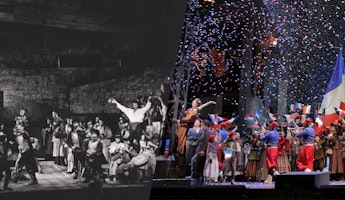Blog
March 19, 2024
From Page to Stage: "La Traviata"
What would the opera world be like without La Traviata? More than 170 years after its first performance, it’s now the most performed opera in the world and draws in opera aficionados and first timers alike. This legendary status wasn’t achieved without a legendary backstory, and we can assure you that La Traviata’s backstory is one for the ages. From the real-life woman whose story inspired La Traviata to one of the most famous opening night disasters in opera, you’re going to want to read this before this masterpiece graces our stage.
Before any version of this story was ever put to page, there was Marie Duplessis (1824-1847), a French courtesan and mistress to many of the most prominent and wealthy men in France. She began her career as a courtesan by the age of 16, when she became aware that men were willing to pay for her company. Shortly after becoming a courtesan, she’d also become the hostess of a salon which was especially popular amongst politicians, writers and artists. This did wonders for her popularity and resulted in her meeting famed author Alexandre Dumas fils (son of Alexandre Dumas père, the celebrated author of The Three Musketeers and The Count of Monte Cristo). Duplessis became the younger Dumas’ mistress from September 1844 to August 1845. Though their relationship didn’t last, they were said to still be in each other’s good graces; Duplessis always made a point of maintaining good relationships with her benefactors even after things had ended between them. On February 3, 1847, Duplessis succumbed to tuberculosis with both her husband and one of her former lovers by her side. Her belongings were auctioned off to pay her debts. A year after her death, Dumas published The Lady of the Camellias, a semi-autobiographical novel based on Duplessis.
The Lady of the Camellias follows Marguerite Gautier, a courtesan suffering from consumption, as she falls in love with a young bourgeois named Armand Duval. The two make plans to live together in the French countryside but Armand’s father convinces Marguerite to leave Armand, telling her that their relationship would cause a scandal that would destroy Armand’s sister’s chance of marriage. Armand is led to believe that Marguerite leaves him for another man. He learns the truth too late, and the couple is reunited only when Marie is on her deathbed. Armand pledges to remain faithful in his love, sending camellias to her grave for the rest of his life.
This story was first adapted to the stage by Dumas himself in 1852. As to how Verdi came across this story, some believe Verdi had read Dumas’ book around the time it came out, but we know for certain that he attended the play with his wife Giuseppina Strepponi. Inspired, Verdi immediately started writing music for La Traviata and asked his longtime librettist Francesco Maria Piave to begin writing the libretto.
The opera would originally be called Violetta, referring to the new name of the main character but would be changed to La Traviata, which translates to The Fallen Woman. Besides name and title changes, the original libretto followed Dumas’ original story closely, with it even being set in the present day (that is, the mid-19th century), which Verdi saw was greatly important to the story. Verdi had a previous contract with the Teatro La Fenice, which meant he needed to have a new opera ready to premiere in March 1853. Verdi was unaware that the contract also stated the opera must take place in the 17th century and with La Traviata being the only opera he had ready, he had to swap the original modern-day setting. Soprano Fanny Salvini-Donatelli was chosen to play the role of Violetta, but Verdi had his doubts about her, especially after reading the reviews she received earlier that season. However, Verdi was unable to secure a replacement in time so rehearsals for La Traviata would begin with Verdi expressing his unhappiness to anyone who would listen to him.
On opening day on March 6, 1853, Verdi was convinced the show would be a disaster, but when the end of the first act came, the theater was filled with applause and cheering. But the tide soon turned. The audience loathed the second act, unimpressed with Lodovico Graziani as Alfredo and Felice Varesi as Giorgio. Fanny Salvini-Donatelli was jeered by the audience who thought she was too old to play Violetta and didn’t fit the part of someone dying from tuberculosis. After the show, Verdi wrote to his friend Emanuele Muzio: “La Traviata last night [was] a failure. Was the fault mine or the singers? Time will tell.”
Despite the failure of opening night, many impresarios around Italy begged Verdi to bring the show to them but he refused, unconvinced that singers could do the piece justice. The only theater to prove that it could be done well was the Teatro San Benedetto and so Verdi would deliver to them a newly revised version of the opera in May 1854. This production saw major success with Maria Spezia-Aldighieri's performance as Violetta receiving unanimous praise. The opera would soon be performed around the world and though people found the plot to be controversial, especially in England, that didn’t stop it from becoming one of the most frequently performed operas during Verdi’s lifetime. Today, it remains the most performed opera of all time.
While there is no shortage of Verdi masterpieces, La Traviata is truly a special opera amongst special operas. Together with Rigoletto and Il Trovatore, it helped solidify Verdi’s musical genius. It’s hard to believe that the story that took the world by storm is all thanks to a single French courtesan. Marie Duplessis’ life may have been a short one but to this day she is remembered, with people still coming to the theater and weeping as they see her story be brought back to life.








/03-cosi/_dsc0996_pr.jpg?format=auto&fit=crop&w=345&h=200&auto=format)

















